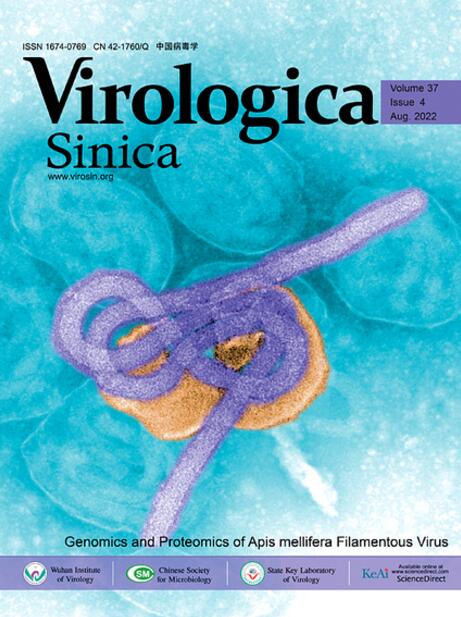病毒受体捕获结合环介导等温扩增快速准确检测传染性SARS-CoV-2
IF 4
3区 医学
Q1 Medicine
引用次数: 0
摘要
快速准确地检测传染性病毒颗粒,而不仅仅是病毒核酸,对于避免不必要的隔离,有效控制2019冠状病毒病(COVID-19)、严重急性呼吸综合征(SARS)、中东呼吸综合征(MERS)等病毒性疾病的传播至关重要。实时定量聚合酶链反应(RT-qPCR)是疫情期间应用最广泛的检测技术。然而,它不能区分完整的传染性病毒和表面扭曲的非传染性病毒颗粒或裸露的病毒RNA。在这项研究中,我们提出了一种结合病毒受体捕获和逆转录环介导的等温扩增(RT-LAMP)的传染性冠状病毒特异性检测策略。我们成功地应用该策略检测了SARS-CoV-2代病毒和人类冠状病毒NL63 (HCoV-NL63)的感染性病毒颗粒。首先在包被重组人血管紧张素转换酶2 (hACE2)受体的ELISA板上捕获病毒颗粒。然后从颗粒中提取病毒RNA,并使用病毒特异性引物进行RT-LAMP检测。在我们的实验环境中,该方法的最低检测限(LOD)为90 PFU/mL,灵敏度为96.2%,特异性为100%。我们的研究提供了一个概念证明,病毒受体捕获结合RT-LAMP可以区分传染性冠状病毒与非传染性病毒粒子或裸病毒RNA。这为这一病毒检测策略成为管理、预防和控制冠状病毒传染病的主流工具铺平了道路。本文章由计算机程序翻译,如有差异,请以英文原文为准。
Rapid and accurate detection of infectious SARS-CoV-2 by viral receptor capture combined with loop-mediated isothermal amplification
Rapid and accurate detection of infectious virus particles, not just viral nucleic acid, is essential to avoid unnecessary quarantine and effectively control the spread of viral diseases such as coronavirus disease 2019 (COVID-19), severe acute respiratory syndrome (SARS), and Middle East respiratory syndrome (MERS). Real-time quantitative polymerase chain reaction (RT-qPCR) was the most widely used detection technique during the COVID-19 outbreak. However, it cannot discriminate between intact infectious viruses and surface-distorted, non-infectious virus particles or naked viral RNA. In this study, we present a strategy for the specific detection of infectious coronaviruses by combining viral receptor capture and reverse transcription loop-mediated isothermal amplification (RT-LAMP). We successfully applied this strategy to detect infectious virus particles of the SARS-CoV-2 surrogate virus and the human coronavirus NL63 (HCoV-NL63). Virus particles were first captured on ELISA plates coated with the recombinant human angiotensin-converting enzyme 2 (hACE2) receptor. Viral RNA was then extracted from the particles and detected by RT-LAMP using virus-specific primers. In our experimental setting, the proposed method had a minimum detection limit (LOD) of 90 PFU/mL, sensitivity of 96.2%, and specificity of 100%. Our study provides a proof-of-concept that viral receptor capture combined with RT-LAMP can differentiate infectious coronaviruses from non-infectious virions or naked viral RNA. This paves the way for this virus detection strategy to become a mainstream tool for the management, prevention and control of epidemic coronavirus diseases.
求助全文
通过发布文献求助,成功后即可免费获取论文全文。
去求助
来源期刊

Virologica Sinica
Biochemistry, Genetics and Molecular Biology-Molecular Medicine
CiteScore
7.70
自引率
1.80%
发文量
3149
期刊介绍:
Virologica Sinica is an international journal which aims at presenting the cutting-edge research on viruses all over the world. The journal publishes peer-reviewed original research articles, reviews, and letters to the editor, to encompass the latest developments in all branches of virology, including research on animal, plant and microbe viruses. The journal welcomes articles on virus discovery and characterization, viral epidemiology, viral pathogenesis, virus-host interaction, vaccine development, antiviral agents and therapies, and virus related bio-techniques. Virologica Sinica, the official journal of Chinese Society for Microbiology, will serve as a platform for the communication and exchange of academic information and ideas in an international context.
Electronic ISSN: 1995-820X; Print ISSN: 1674-0769
 求助内容:
求助内容: 应助结果提醒方式:
应助结果提醒方式:


